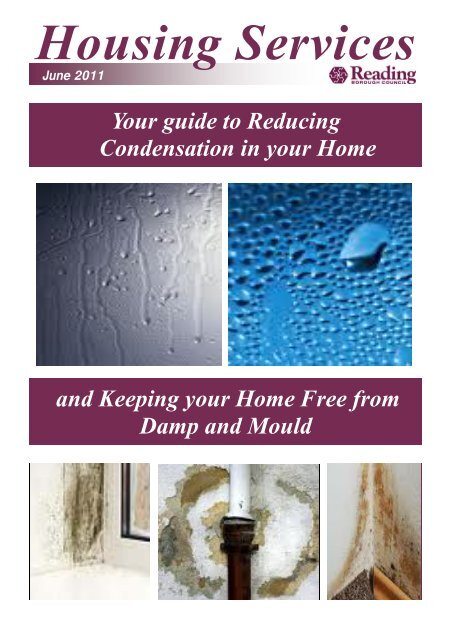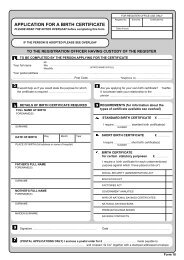Reducing Condensation in Your Home - Reading Borough Council
Reducing Condensation in Your Home - Reading Borough Council
Reducing Condensation in Your Home - Reading Borough Council
- No tags were found...
You also want an ePaper? Increase the reach of your titles
YUMPU automatically turns print PDFs into web optimized ePapers that Google loves.
Hous<strong>in</strong>g ServicesJune 2011<strong>Your</strong> guide to <strong>Reduc<strong>in</strong>g</strong><strong>Condensation</strong> <strong>in</strong> your <strong>Home</strong>and Keep<strong>in</strong>g your <strong>Home</strong> Free fromDamp and Mould
Damp and MouldDamp, condensation and mould are common problems <strong>in</strong> manyproperties. Damp or mouldy environments may causerespiratory health problems to worsen. It is important that youtake steps to reduce damp and mould <strong>in</strong> your propertyTypes of damp <strong>in</strong> the homePenetrat<strong>in</strong>g Damp is caused by waterseep<strong>in</strong>g <strong>in</strong>to the property from leak<strong>in</strong>gpipes, gutter<strong>in</strong>g, overflows or holes <strong>in</strong>the roof etc. This type of damp leaves a‘tidemark’ around the affected area.Ris<strong>in</strong>g damp (ground floor only) is caused by moisture <strong>in</strong>the ground be<strong>in</strong>g sucked up by the walls ofthe property. This is due to a defective ormiss<strong>in</strong>g damp-proof course. The damp will notrise more than a metre up the wall fromground level.Ris<strong>in</strong>g damp can cause flak<strong>in</strong>g plaster andrender and salt deposits may be seen on<strong>in</strong>ternal walls and external brickwork.<strong>Condensation</strong> is the most common type of damp. There isalways moisture <strong>in</strong> the air and when theair reaches cold surfaces (like w<strong>in</strong>dows)t<strong>in</strong>y drops of water appear.<strong>Condensation</strong> mostly appears dur<strong>in</strong>g coldweather <strong>in</strong> places where there is littlemovement of air, for example <strong>in</strong> cornersof rooms, beh<strong>in</strong>d wardrobes and nearw<strong>in</strong>dows. Cont<strong>in</strong>ual exposure to moisture will cause mould togrow <strong>in</strong> these places.2
Can I get rid of condensation?Yes - there are a number of th<strong>in</strong>gs that you can do to reduceand even get rid of condensation from your home.1. Make less moistureWipe the water from your w<strong>in</strong>dows and sills with acloth - but make sure you wr<strong>in</strong>g your cloth out <strong>in</strong> the s<strong>in</strong>k. Lotsof people put the wet cloth on a heater to dry – the water thenevaporates back <strong>in</strong>to the air and re-appears as condensationwhen the temperature drops.Wipe the water off every time it appears to get rid of the excessmoisture <strong>in</strong> your home.Don’t dry wash<strong>in</strong>g <strong>in</strong>side your home –all the water from your clothes will gostraight <strong>in</strong>to the air and as soon as the aircools you will get condensation on yourw<strong>in</strong>dows and walls.Put lids on your saucepans when cook<strong>in</strong>g – thiskeeps steam <strong>in</strong> the pan and saves money on your fuel bill.Don’t use paraff<strong>in</strong> or bottled gas heaters – they producelots of moisture – burn<strong>in</strong>g one gallon of paraff<strong>in</strong> puts about onegallon of water vapour <strong>in</strong>to the air which re-appears ascondensation on your w<strong>in</strong>dows or other cold surfaces.Vent your tumble dryer outside – ifyour dryer is not self condens<strong>in</strong>g make sureyou put the hose out of a w<strong>in</strong>dow to ensurethe hot moisture filled air produced by themach<strong>in</strong>e does not condense <strong>in</strong>side your home.Open<strong>in</strong>g a w<strong>in</strong>dow is not enough.You can get hose kits from most electrical andDIY stores.3
2. Increase the ventilationUse the trickle ventilators or night vents <strong>in</strong> yourw<strong>in</strong>dows. You need a good air flow to helpget rid of moisture which is produced <strong>in</strong> yourhome all the time. Modern w<strong>in</strong>dows have pulldown flaps to help ventilate your home – keepthese open as much as possible so damp aircan escape. Some w<strong>in</strong>dows have a night ventso the w<strong>in</strong>dow can be locked with it open just 15 to 20 mm4Trickle VentOpen a w<strong>in</strong>dow when cook<strong>in</strong>g and after shower<strong>in</strong>g/bath<strong>in</strong>g. Boil<strong>in</strong>g pans, hot baths and showers produce lots ofsteam – open<strong>in</strong>g a w<strong>in</strong>dow ensures thissteam condenses outside rather than <strong>in</strong>sideyour home. It also helps to keep yourkitchen and bathroom doors shut whenthese rooms are <strong>in</strong> use and for about 20m<strong>in</strong>utes after to stop moist air gett<strong>in</strong>g <strong>in</strong>toother rooms. When your kitchen, bathroomor other rooms are not <strong>in</strong> use, leave doors open so heat canspread evenly through your home.Allow air to circulate where possible. Avoid putt<strong>in</strong>gfurniture aga<strong>in</strong>st outside walls of your home. Inside walls(between rooms) are always warmer and are less prone tocondensation. Leave a gap between the wall and the furniture soair can circulate and ensure that wardrobes and cupboards areproperly ventilated to prevent mould grow<strong>in</strong>g <strong>in</strong>side them.3. Keep your home warmWhen moisture condenses on your walls itmakes them colder. This causes you to loseheat and <strong>in</strong>creases the risk of mould grow<strong>in</strong>g. Itthen takes more energy to heat your home to acomfortable temperature which costs more.
Heat<strong>in</strong>g your home efficiently helps reduce condensation andcould save money on your heat<strong>in</strong>g bills. Its important to keepyour home above 18 °C (63°F ) most people f<strong>in</strong>d a comfortableheat is around 21°C (70°F). <strong>Condensation</strong> is sure to occur if youlet your home fall below 18°C4.Remove mould as soon as you f<strong>in</strong>d itYou MUST remove mould as soon as you f<strong>in</strong>d it to stop itspread<strong>in</strong>g and caus<strong>in</strong>g more damage to your home. You can getspecial clean<strong>in</strong>g products from DIY stores (always follow themanufacturers <strong>in</strong>structions) or use a good quality bleach mixed 1part bleach to 4 parts water (but remember bleach may take thecolour out).How to run storage heaters efficientlyStorage heaters have 2 dials under the flap:•An “OUTPUT” or“ROOMTEMERATURE”dial whichcontrols theamount andspeed at whichheat is released <strong>in</strong>to your room dur<strong>in</strong>g the day•An “INPUT” or “AUTOSET” dial which controls the amountof heat which goes <strong>in</strong>to the storage heater overnight.Sett<strong>in</strong>g your controls as shown <strong>in</strong> the table below is the mostefficient way to run storage heaters and this will help reduce therisk of condensation <strong>in</strong> your home.Input or Auto set Set control between 5& 6Ensures heater is fullycharged overnightOutput or RoomTemperatureSet controlBetween 2 & 35Ensures heat is released at aconstant rate dur<strong>in</strong>g the day
Po<strong>in</strong>ts to RememberProduce less moisture:•Cover your saucepans when cook<strong>in</strong>g•Dry your wash<strong>in</strong>g outdoors•Vent your tumble dryer to outside•Avoid us<strong>in</strong>g paraff<strong>in</strong> or flueless bottled gas heatersVentilate to remove moisture:•Open a w<strong>in</strong>dow when someone is <strong>in</strong>•Increase ventilation <strong>in</strong> the kitchen and bathroom•Shut the bathroom/kitchen doors when cook<strong>in</strong>g/bath<strong>in</strong>g•Ventilate cupboards wardrobes and do not block vents <strong>in</strong>chimneysInsulate and draught proof:•Check that your loft is properly <strong>in</strong>sulated•Draught proof w<strong>in</strong>dows and external doors•Consider cavity <strong>in</strong>sulation if not doneHeat your home a little more:•Keep low background heat on all day (if possible)•F<strong>in</strong>d out about benefits and help with fuel billsDO NOT:•Turn your radiators or storage heaters off•Turn off or isolate extractor fans•Dry your wash<strong>in</strong>g on radiators•Put too many clothes <strong>in</strong> your wardrobes/cupboards•Use wash<strong>in</strong>g up liquid to wipe down mould•Pa<strong>in</strong>t over mould. It must be properly cleaned and pa<strong>in</strong>tedover with special pa<strong>in</strong>t available from your local DIY storeREMEMBER:The only last<strong>in</strong>g way of avoid<strong>in</strong>g severe mould is to elim<strong>in</strong>atedampness. <strong>Condensation</strong> causes damp and then will lead tomould. The only real way to reduce condensation is heat andventilation.6
Useful ContactsHous<strong>in</strong>g repairs: 0800 318 296Neighbourhood Services: 0118 937 2161Hous<strong>in</strong>g Compla<strong>in</strong>ts 0118 937 2905Energy Sav<strong>in</strong>g TrustThe Energy Sav<strong>in</strong>g Trust is a non-profit organisation that providesfree and impartial advice on how to reduce the amount ofenergy you use and save moneyFree advice for householders: 0800 512 012Web:www.energysav<strong>in</strong>gtrust.org.ukJobcentre Plus &DirectgovFor <strong>in</strong>formation and advice about benefits and cold weatherpayments:Jobcentre Plus: 0845 604 3719Adelphi House, Friar Street, Read<strong>in</strong>g RG1 1HDWeb: www.direct.gov.uk/en/moneytaxandbenefits7
If you need help to understand how to reduce condensation anddamp <strong>in</strong> your home please contact your Neighbourhood Officeron 0118 937 2161The <strong>in</strong>formation <strong>in</strong> this booklet is available <strong>in</strong> other formats (suchas Braille or audio) or languages on request.Please contact Neighbourhood ServicesRead<strong>in</strong>g <strong>Borough</strong> <strong>Council</strong> Hous<strong>in</strong>g Services, PO Box 2624,Read<strong>in</strong>g RG1 7WB8
















